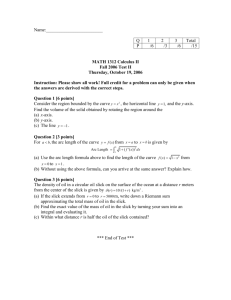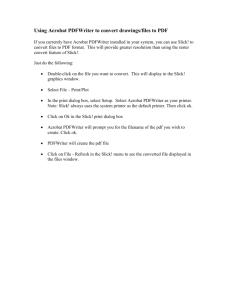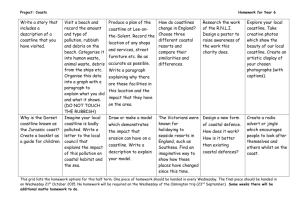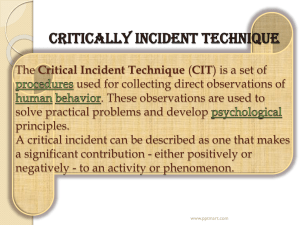Sjon Huisman OIL SPILLS: EFFECTS AND MANAGEMENT
advertisement
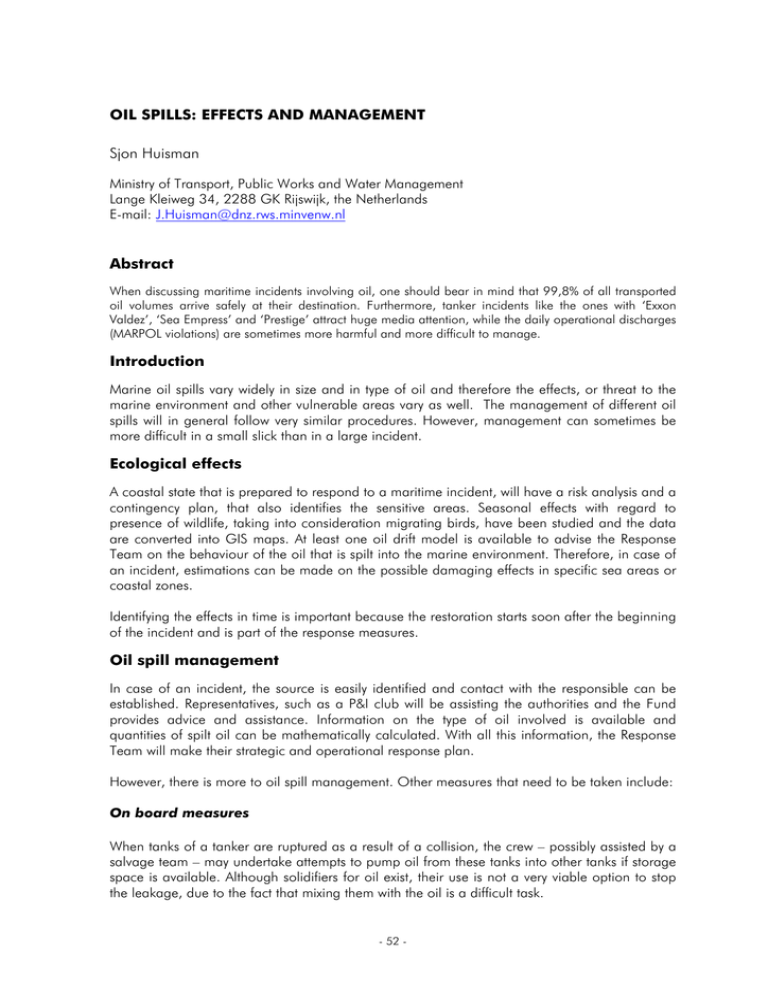
OIL SPILLS: EFFECTS AND MANAGEMENT Sjon Huisman Ministry of Transport, Public Works and Water Management Lange Kleiweg 34, 2288 GK Rijswijk, the Netherlands E-mail: J.Huisman@dnz.rws.minvenw.nl Abstract When discussing maritime incidents involving oil, one should bear in mind that 99,8% of all transported oil volumes arrive safely at their destination. Furthermore, tanker incidents like the ones with ‘Exxon Valdez’, ‘Sea Empress’ and ‘Prestige’ attract huge media attention, while the daily operational discharges (MARPOL violations) are sometimes more harmful and more difficult to manage. Introduction Marine oil spills vary widely in size and in type of oil and therefore the effects, or threat to the marine environment and other vulnerable areas vary as well. The management of different oil spills will in general follow very similar procedures. However, management can sometimes be more difficult in a small slick than in a large incident. Ecological effects A coastal state that is prepared to respond to a maritime incident, will have a risk analysis and a contingency plan, that also identifies the sensitive areas. Seasonal effects with regard to presence of wildlife, taking into consideration migrating birds, have been studied and the data are converted into GIS maps. At least one oil drift model is available to advise the Response Team on the behaviour of the oil that is spilt into the marine environment. Therefore, in case of an incident, estimations can be made on the possible damaging effects in specific sea areas or coastal zones. Identifying the effects in time is important because the restoration starts soon after the beginning of the incident and is part of the response measures. Oil spill management In case of an incident, the source is easily identified and contact with the responsible can be established. Representatives, such as a P&I club will be assisting the authorities and the Fund provides advice and assistance. Information on the type of oil involved is available and quantities of spilt oil can be mathematically calculated. With all this information, the Response Team will make their strategic and operational response plan. However, there is more to oil spill management. Other measures that need to be taken include: On board measures When tanks of a tanker are ruptured as a result of a collision, the crew – possibly assisted by a salvage team – may undertake attempts to pump oil from these tanks into other tanks if storage space is available. Although solidifiers for oil exist, their use is not a very viable option to stop the leakage, due to the fact that mixing them with the oil is a difficult task. - 52 - Transhipment If a tanker is ruptured due to grounding on pinnacles or in case the on board measures fail, another tanker can be brought near the casualty and cargo can be transported from the damaged tanks into the tanker brought alongside. Usually however, the required tanker will not be available. In that case, a sea going barge could be used as a temporary storage facility. Transhipment is not an easy operation and safety procedures are to be closely attended, due to the flashpoint of the oil. As oil is leaking, there is risk of explosive gases in the area. Monitoring, first phase To follow the outflow of oil from the tanker, continuous monitoring of the situation is necessary. A possible way to do this is to follow the leakage from the tanker instruments, but that strongly depends on the situation of the casualty. Alternatively, aerial surveillance can be performed, supported by satellite images. Both detection instruments and visual observation in combination with the Bonn Agreement Colour Code will provide details on extensions of the slick, the assessed volume and the drift of the slick. Aircrew can also give guidance to response vessels in case of mechanical recovery. The rule of thumb that after a few hours 90% of the recoverable oil is in 10% of the slick may help. Dispersant spraying, depending on the type of oil and the weather conditions, requires dedicated guidance from experienced surveillance crew. Monitoring, second phase Monitoring may continue, but with another objective, when oil has entered into a sensitive area or at the coastline. If removal of the oil is impossible or dissuasive, because removal may cause more damage than the oil itself, natural degradation and also the restoration process should be monitored. Response at sea and at the coastline Based on the information gathered through communication with the captain and with the crew of the surveillance or observation aircraft, supported by oil drift trajectory models, the response options are defined. Some coastal states apply dispersants, of which the advantage is the rapid deployment, but one of the disadvantages is that the oil is not removed from the environment. Furthermore, the dispersants could fail because of the type of oil. Mechanical recovery is costly but effective in the sense of removing oil from the marine environment and, if deployed quickly and well managed, it is efficient. Also depending on sea conditions, sometimes the only response option is waiting for the oil to reach the coastline and start the clean-up operation. However, coastal clean up is recognized to be very difficult and sometimes dangerous, depending on the type of coast. Pictures taken at the Spanish coastline, rocky and open to strong waves, express the difficulties encountered. On the other hand, the sandy coastline and smooth slope of the coastline of the Dutch coast appears to be a relatively easy job. Protection of sensitive areas Studies on sensitivity have been made with the objective to protect the same in case of a floating oil slick. So, if possible, the sensitive area should be protected. Floating oil booms to guide the oil to another area could be considered, but require a discussion on the acceptance to sacrifice another area. Moreover, using booms as a barrier to protect an area is difficult and depends on the weather conditions. - 53 - Logistics Response needs logistics, not only for deployment of equipment in the right area but also for transport of collected waste (oil/sand/debris mixtures) from the coastline to a waste treatment. Recovered oil at sea needs to be brought to a refinery or a temporary storage facility. Protective measures are to be considered as the recovery ship may be contaminated with oil from the spill site: oil may stick to the hull and leave a sheen when sailing or berthed in port. Administrative aspects Managing an oil incident includes various administrative aspects, such as the legal side (liability), registration of equipment deployed, contracting commercial supporting companies, contracting temporary storage and waste treatment, logging and drafting situation reports. Preparative work to file a claim also starts here. Claim management is an important subject in oil spill management. Press Depending on the size of the incident and the ecological and social effects, media attention consumes enormous manpower. Press releases and press conferences need to be well prepared. The press officer has to play a very active role in the response team meetings. International co-operation A tanker incident occurring in the EEZ of a coastal state may also affect the interests of an adjacent state and even if not, their assistance is required for combating the oil slick. The Bonn Agreement, for instance, identifies specific co-operation in case of incidents. Sharing information but also active assistance through surveillance operations or recovery vessels have proven to be a strong chain of the regional co-operation. Contracting Parties to the Bonn Agreement and similarly those in HELCOM or Barcelona agreed to co-operate in case of emergencies and this also requires training and exercise. Understanding the equipment and procedures of member states and the skills and level of preparedness create a solid basis to rely on in case of need of assistance. A ‘strike team’ can operate independently as long as the National On-Scene Commander coordinates the response units. All the aforementioned subjects, although in brief, give some indication what managing oil incidents implies. Each subject in itself could be thoroughly discussed in a day’s meeting. The Response Team leader, no matter in what way organisational arrangement have been made, is to co-ordinate all these aspects. Obviously, experts in the various fields will carry out the tasks, but a good view on all aspects is required. The other slick Knowing the party to talk to and co-operate with, in case of an oil incident, is an obvious necessity. The coastal state authorities have identified the responsible and liable party that may even contract a salvage team or response assistance. Although it requires time to settle the claim, at least there is a party to negotiate or quarrel with. In cases where coastal authorities are confronted with a so-called mystery slick, still requiring a response operation, finding the perpetrator is less obvious. - 54 - Sample analysis may give information on the type of oil and could give an indication of weathering; AIS data may even identify some vessels in the area where the slick was found, but solid prove that a ship has discharged oil is another piece of cake. Operational, bilge discharges (MARPOL violations) are often found without a trace of the polluting vessel. Bilge discharges or slob tank cleaning can result in considerable volumes of oil at sea, requiring a response operation. The example of the ‘Borcea’ In the case of the motor vessel ‘Borcea’ (1989), the Dutch authorities were dealing with an unidentified source of pollution that had spilt several hundreds of tons of heavy fuel oil that washed ashore between the Western Scheldt and Scheveningen. Also birds contaminated with oil were found, a few hundred were killed and only a limited number could be cleaned and brought back into their habitat. The response operation, as was clear from the first report and inventory, would be a costly operation. But who and where was the polluter? A message was put in the Paris MOU box and faxes were sent to Bonn Agreement focal points. The amount of oil spilt, so much was clear, certainly must have come from a bunker or cargo tank. This was not a MARPOL violation. Fortunately through the Bonn Agreement network the vessel was found and later on it was proven that she had spilt the oil. From a management point of view, the response operation took some nine days (beach cleaning), but the investigations to find the polluter and the work resulting in a court case required many more days thus affecting the workload of the organization. Although the effects of the pollution may not be different, the managing part has a different content and also requires detective forces. In the Netherlands the so-called water police plays an important role. Obviously sample analysis is of utmost importance to find specific characteristics in the oil. In the case of the ‘Borcea’ the laboratory experts concluded that the oil was a poorly refined product coming from wells in the Caucasus. That information limited the number of vessels to investigate and on the basis of the oil drift trajectory model, the time frame could be defined. This combination of information of data compared with ships registered in Eastern European Countries that had been in ports in France, Belgium or the Netherlands simplified the research. However, the fortunate discovery in Norway identified the vessel as she had required assistance to repair a ruptured fuel tank. In Response Organizations the person in charge has to be prepared to deal with all these aspects. There is no specific study in this field. Seminars and workshops, co-operation in regional agreements and the exchange of experiences should be used to get skilled. - 55 -
